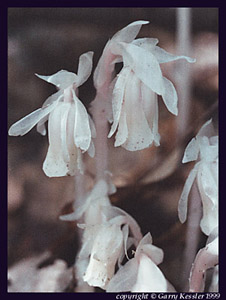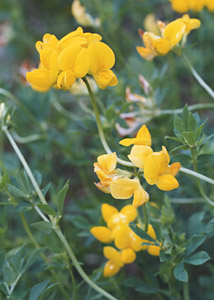
Indian-pipe, Wintergreen or Pyrola family (Pyrolaceae), Native
 |

Indian pipes are saprophytic plants, living off dead plant matter, especially decaying tree roots.
They get their nutrients with the help of various soil fungi but are not a fungus themselves.
They are flowering plants that have lost their leaves and their green chlorophyll in the course of
evolution. Indian pipes are native to North America and can be found across the continent.

Birdfoot Trefoil, Pea family (Leguminosae), Alien

|

A small, showy member of the pea family, birdfoot trefoil (Lotus corniculatus) has clusters of bright
yellow flowers. The name comes from the arrangement of the seed pods, which suggest a bird's foot. Like
other legumes, this plant has a symbiotic relationship with certain soil bacteria that adds nitrogen to the
soil in a form that plants can use as a nutrient.
Birdfoot trefoil also prospers in the lawn-like areas around shopping center parking lots in Westborough.
It first blooms in June but continues throughout the summer if there is enough rain.
Yellow Goat's-beard, Composite or Daisy family (Compositae), Alien
|

Like its relative, the dandelion, yellow goat's-beard flowers transform themselves into round, feathery seedheads. These sizable blowballs are much larger and more striking than those of the dandelion.
In the past, yellow goat's-beard had various medicinal uses. It also had value as a food. Its roots were
eaten like parsnips, and its stalks were eaten like asparagus.
| show TOC frame | Table of Contents | 
|
| Home / Contact | ||
Copyright © Anne A. Reid, 1999-2002. Photographs copyright © Garry K. Kessler, 1999-2002. | ||